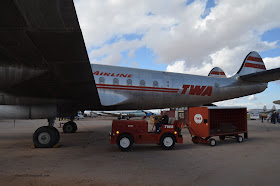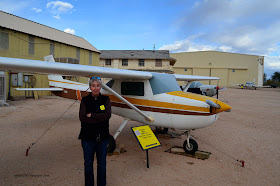Today we went to the Pima Air & Space Museum.
It is just south of Tucson next to Davis-Monthan AFB.
It is a large (80 Acre) Collection of over 300 aircraft spanning
over 100 years of aviation history.
All this is set against the backdrop of arriving and departing Air Force
Jets silhouetted against the nearby mountains.
As a licensed pilot - I was like a kid in the candy shop.
I'd like to talk about every plane that we visited & photographed,
but I'll try to keep the list reasonably short.
I'm going to put the aircraft in a chronological order so you can
see the evolution.
First the Bombers
The B24 Liberation was a 4-engine WWII era bomber that saw action
in every theatre by every service. It was the most produced
aircraft of the war. They were retired from military service immediately
after the war but continued to see forest fire service into the 1990's.
It had a top speed of 290 mph with a 2,100 mile range.
The Boeing B29 Superfortress was introduced towards the end of WWII.
It was designed as a "Hemisphere Defense Weapon"
It's 4 piston engines developed 2,200 HP each.
It carried more bombs, higher, farther, and faster, than any
aircraft prior to its introduction and was quite advanced for its time with
features such as pressurized crew areas, electronic bomb controls
and remote control machine gun turrets.
It is most noted as being the type of aircraft that dropped
the Atomic Bombs on Japan ending WWII
It had a top speed of 358 mph with a 4,100 mile range.
Our next bomber-
The Convair B36 - was a unique aircraft in many ways.
It was the last of the piston powered bombers and bridged the gap between
the WWII era aircraft, and the jets that are now commonplace.
Even though it was technically obsolete by the time it entered service its
predecessor, the B47 did not have the ability to carry the heavy early
generation nuclear weapons of the time, so the B36 remained an important
part of our arsenal during the early days of the Cold War.
It had 6 pusher piston engines that put out over 3,000 hp each.
2 jet engines were later added at the outboard end of each wing
to reduce the takeoff roll. With its 10 engines- "6 to turn and 4 to burn"
was the phrase its pilots used to describe its power plants.
It had a top speed of 435 mph with a 10,000 mile range.
The Boeing B47 was the first all jet bomber built anywhere in the world.
While the Air Force had issued a jet bomber requirement in 1941, it was not
until the end of the war when German Jet Engine research information became
available that the B47 was developed.
It was developed with one mission in mind... to drop atomic bombs on the
Soviet Union. Unlike the earlier B36 however it lacked the long-range and thus
required mid-air refueling to complete its missions.
The B47 was the aircraft featured in the book and later the movie "Fail Safe".
It had a top speed of 606 mph with a range of 4,000 miles.
Finally in the bomber category is the modern big boy of the group - The B52.
With its 8 jet engines it can carry a massive 70,000 lb bomb payload
at 635 mph for 7,100 miles.
During the liberation of Kuwait - the B52 provided many of
Saddams Republican guard their goal of a face to face with Allah.
There are still about 85 of them in service.
The fighters
The F4 Cosair is perhaps one of the most recognizable fighters of WWII
It was a carrier based attack fighter that was produced thru 1952 seeing duty
in Korea as well.
You might remember this aircraft from the show about Pappy Boyington
and the "Black Sheep" squadron.
Its speed was over 400 mph.
Another recognizable fighter was the P51 Mustang.
The Mustang was arguably the finest fighter of WWII.
It was first produced at the request of the British Government whose
requirements stipulated that a prototype be ready in 120 days!
So - in the pre-computer days of slide rules and mathematics using paper
and pencil - the finest aircraft of the war was designed in 4 months!
It was a land based fighter that saw action in the European & Pacific Theatre.
It had a top speed around 440 mph.
Bring on Tom Cruise & Top Gun.
You might recognize the aircraft below from that movie.
The F14 Tomcat was a carrier based attack craft that was retired from
Naval Service in 2006.
It had a top speed over 1,500 mph!
Other Aircraft
The C47 is the military version of the DC3.
This aircraft probably deserves as much credit for our victory in WWII
as any. It was used for cargo transport, carrying troops, paratroopers, towing
gliders... you name it.
After the war it saw service with the airlines as a commercial airliner.
There are many still in service today in various roles around the world.
The baby below is one of the Bells of the Ball.
The SR71 Blackbird was the last of the aircraft designed & built by
the Secretive Lockheed Skunkworks.
The first one was built in 1964, but even today it is hard to overstate
the technological achievements represented by this aircraft.
Built as a spy plane to replace the U2, the SR71 still holds numerous records.
Worlds Absolute Speed Record 2,193 mph
Record for Sustained Altitude 85,069 ft.
NY to London 1 hr 55 minutes.
LA to Wash DC 1 hr 4 minutes.
This is one Beautiful Bird.
The VC118/Douglas DC6 saw service as a commercial airliner.
This one below was Eisenhowers, then JFK's Air Force One until
Kennedy replaced it with a jet - the 707.
Around the same time - the Lockheed Constellation was providing
comfort and safety for the traveling public.
The "Connie" used the same engines as the B29.
Here is Kate doing the job that she did at Northwest.
Look at the line of this Aircraft.
Designed with sliderules.
The Boeing 707 ushered in the era of Jet Travel.
I traveled on a PanAm 707 to Europe when I was a kid.
This one served to transport VIP's
Last but not least - the Cessna 150.
This 2 seat monster is the first plane that I ever flew myself.
It has 100 HP, a blistering top speed of 125 mph
and about a 740 mile range.
If you've made it this far... congratulations. You must like planes!
As we left the Museum, the skies to the north had darkened and you could
see that precipitation of some type was falling.
On the way home we drove thru some showers as the temps dropped into
the mid 40's.
Soon we got some glimpses of new snow on the peaks above.
It was an interesting & informative day.
I hope you've enjoyed visiting the Museum with us.






















































